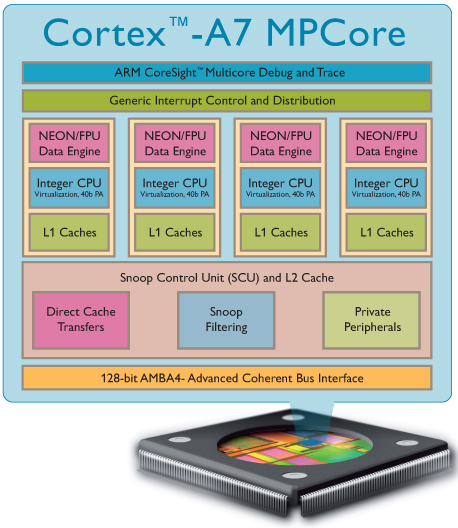ARM Reveals Cortex-A7 Chip, big.LITTLE Processing
ARM has revealed a new processor and a technology that will switch between two processors within a single SoC for better performance and battery life.
Sub-$100 entry level smartphones will soon get a little extra skip in their step thanks to the ARM Cortex-A7 MPCore processor. Revealed on Wednesday, ARM claims the new chip is the most energy-efficient application class processor ARM has developed to date, delivering 5x the energy-efficiency and significantly greater performance while remaining one-fifth the size of the Cortex-A8 processor.
The company also revealed what it calls big.LITTLE processing which essentially controls two compatible but different processors installed within a single SoC. Power management software will select the appropriate processor for the task at hand, using the "LITTLE" lowest-power processor like the new Cortex-A7 for running the operating system and basic apps. Gaming and navigation would be handled by the faster Cortex-A15 processor, or both, depending on the app's hardware demand.
"The time for this migration is in the order of 20 microseconds," the company explained on Wednesday. "The efficient and seamless switching of workloads between the two processors is supported by advanced ARM system IP, such as AMBA 4 ACE Coherency Extensions. This ensures full cache, I/O and processor-to-processor coherency between the Cortex-A15 and Cortex-A7, and across the complete system. Software and applications can therefore continue to run unhindered, and unnoticed by the user, as the tasks are rebalanced to provide the optimum big.LITTLE user experience."
As for the new processor, ARM claims that it will deliver sub-$100 entry level smartphones in the 2013-2014 timeframe with an equivalent level of processing performance to today’s $500 high-end smartphones. Manufactured using 28-nm process technology, it will occupy less than 0.5mm2 of space. ARM Partners already supporting both technologies include Broadcom, Compal, Freescale, HiSilicon, LG Electronics, Linaro, OK Labs, QNX, Redbend, Samsung, Sprint, ST-Ericsson and Texas Instruments.
"TI's OMAP platform success relies on superior mobile computing at ultra-low power to deliver extraordinary experiences on smartphones, tablets and ultrathin laptops," said Remi El-Ouazzane, vice president, OMAP platform business unit, Texas Instruments. "Our mobile processors' smart multicore architectures have long been complementing main ARM processors with specialized engines and accelerators better suited to perform certain tasks at the lowest possible power. We are excited to see ARM's introduction of Cortex-A7 with big.LITTLE processing. We see it as a natural continuation of our innovative approach to smart mobile computing as it presents new opportunities to advance the industry overall enabling even lower power general purpose CPU performance."
For more information on the Cortex-A7, head here. Further details regarding big.LITTLE processing can be acquired here.
Get Tom's Hardware's best news and in-depth reviews, straight to your inbox.

Kevin Parrish has over a decade of experience as a writer, editor, and product tester. His work focused on computer hardware, networking equipment, smartphones, tablets, gaming consoles, and other internet-connected devices. His work has appeared in Tom's Hardware, Tom's Guide, Maximum PC, Digital Trends, Android Authority, How-To Geek, Lifewire, and others.

